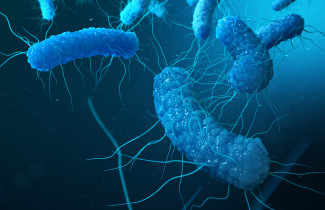Researchers discovered a substance that can stop pathogens from invading cells.
“This represents a much needed new approach to tackle antibiotic resistance”, says Professor Antti Poso from the University of Eastern Finland. He took part in the research collaboration led by the University of Tübingen and the German Center for Infection Research.
Pathogenic Salmonella injects effector proteins into the cells of the gastrointestinal tract to penetrate and multiply within them. The bacteria are usually ingested with contaminated food. They can cause serious gastrointestinal inflammation and even systemic infections. Now, the international research team has discovered a substance that can stop the process of infection early on. The synthetic substance C26 inhibits the injection of effector proteins. It could be developed into a drug for combating Salmonella infections in humans and animals. The discovery was published in the journal Science Advances.
Salmonella has developed multiple resistance mechanisms to antibiotics. As a result, a treatment alternative is needed urgently. Pathoblockers present such an alternative. The discovered substance acts early, before the bacteria penetrate the tissues, by specifically targeting and disrupting the infectious mechanisms of the pathogen. As the substance has a very specific and targeted effect against Salmonella, it would much be less likely to acquire resistance against the pathoblocker from other bacteria.
No harm to useful microbiome
While attacking their target tissue in the gastrointestinal tract, Salmonella set in motion secretion systems that rely on several transcriptional regulators. One of them, named HilD, has a central role in the entry of Salmonella into the host cell. Within the structure of HilD, the researchers identified a suitable target for new drug candidates. In order to transmit signals for protein synthesis, the regulators must bind highly specifically to other regulators and DNA and trigger further reactions. It turns out that HilD has a druggable pocket. On a molecular level, it can be imagined as an intricately shaped, three-dimensional pocket. The discovered substances fit precisely in this pocket and as a result, disrupt the function of the regulator. In this way, the process of infection can be stopped.
The research team screened large compound libraries for potential candidates, using Finland’s national supercomputers at CSC’s data center in Kajaani and methodology developed at the University of Eastern Finland. A promising substance called C26 was identified. The researchers analysed its mode of action and its precise binding site on the structure of HilD. The efficiency of C26 in disrupting infection was then tested. The tests proved for example that the inhibitor interferes with the pathogenicity of bacteria hiding inside macrophages – the cells of the immune system of the host. According to the results, C26 could stop the process of Salmonella infection early on at the central regulator HilD.
The team now has a suitable precursor for further drug development. However, the route to treating Salmonella infections with pathoblockers such as HilD inhibitors is still long.
Aside from human use, these treatments could also be developed for veterinary medicine, particularly for poultry. Unlike antibiotics, which also damage the patients’ useful intestinal bacteria in many ways, specific pathoblockers are not expected to have any negative effects on the body and its own microbiome.
Research article:
Abdelhakim Boudrioua, Joe D. Joiner, Iwan Grin, Thales Kronenberger, Vadim S. Korotkov, Wieland Steinchen, Alexander Kohler, Sophie Schminke, Julia-Christina Schulte, Michael Pietsch, Arun Naini, Simon Kalverkamp, Sven-Kevin Hotop, Travis Coyle, Claudio Piselli, Murray Coles, Katharina Rox, Matthias Marschal, Gert Bange, Antje Flieger, Antti Poso, Mark Brönstrup, Marcus D. Hartmann, Samuel Wagner: Discovery of synthetic small molecules targeting the central regulator of Salmonella pathogenicity. Science Advances, https://doi.org/10.1126/sciadv.adr5235




